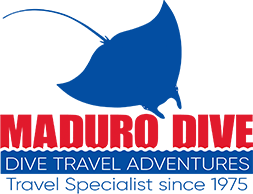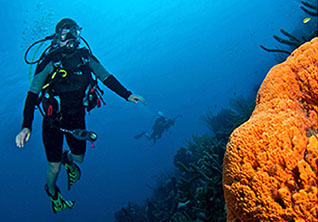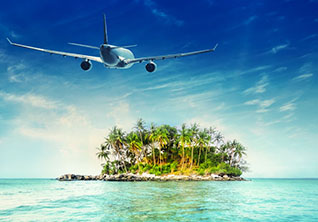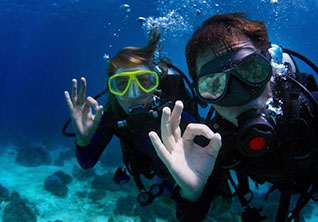It's the start of the summer SCUBA diving season and many previously certified divers are looking to expand their diving knowledge and try some new experiences. One sure way to do this is through advanced or specialty courses.
According to PADI, the world's largest scuba diver certification organization, there are a large number of scuba diving specialty programs. Here's a look at the top five:

Enriched Air Diver: This is also commonly referred to as "Nitrox" diving. The concept is actually pretty simple - "nitrox" divers breathe a different mixture of air and nitrogen than what we all breathe on land. By changing the composition of the gas the diver puts in his tank, there is less risk of decompression sickness (also known as the bends). A side benefit of enriched air diving is that scuba divers can spend more time under the water and often the "Nitrox" in their tanks can make divers feel less tired and more energetic following a dive.
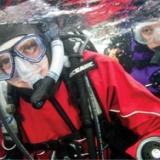
Dry Suit Diver: Dry suits allow divers to explore more challenging dive sites. The special combination of a rubber outer shell seals out the colder water, keeping the diver not only warmer, but dry! This specialty teaches divers about using the right cold water scuba diving attire, which allows for the generally better visibility offered during the winter months especially at inland dive sites such as quarries, lakes, sinkholes and caves etc.
Deep Diver: Normal scuba diving training is designed to allow divers to dive safely to depths up to 60 feet. Anything deeper than that is typically considered a "deep dive". The Deep Diver course is designed to train divers to safely explore depths of between 60 and 130 feet. The course covers a variety of procedures and skills including how to manage your depth, deal with nitrogen narcosis, plan safety stops and deal with situations that can occur in deeper waters.Wreck Diver: Many divers who complete the "deep diver" course also choose to take the popular "wreck diver" specialty course. This course helps divers explore the fascinating world of underwater wrecks and submerged structures. The course teaches how to select the proper equipment for diving on wrecks, how to safely explore and enter wrecks, research and plan these popular dives. Wreck diving is quickly becoming one of the more popular activities in the United States due to the increase in the number of artificial reefs being created.
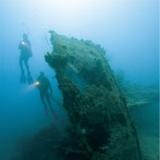
Wreck Diver: Many divers who complete the "deep diver" course also choose to take the popular "wreck diver" specialty course. This course helps divers explore the fascinating world of underwater wrecks and submerged structures. The course teaches how to select the proper equipment for diving on wrecks, how to safely explore and enter wrecks, research and plan these popular dives. Wreck diving is quickly becoming one of the more popular activities in the United States due to the increase in the number of artificial reefs being created.
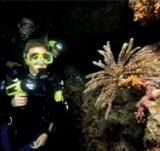
Night Diver: It may sound scary or intimidating at first, but scuba diving at night has some very appealing features. The behavior of the marine life underwater changes at night. Critters that are darting back and forth during the day are suddenly more subdued and easy to observe. Some creatures come out ONLY at night. The course teaches proper use of dive lights, ropes, signal devices and how to safely scuba dive at night.
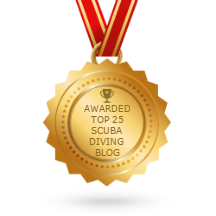
Recent Posts
- Finding the Right Dive Resort For Your Vacation
- Luxury Dive Resorts That Offer Unforgettable Experiences
- Eastern Malaysia, Sabah, Sipadan & More
- Ghost Pipefish, Pipefish, Seahorses, and Sea Dragons
- Australia Queensland and the Great Barrier Reef
- Tioman Islands, Malaysia
- The Riviera Maya
- The Peter Diving System
- The Bay Islands, Roatan, Utila, Guanaja, and more.
- The Cuttlefish; The Undisputed Master of Camouflage.
Categories
- Australia
- Bahamas
- Bay Islands
- Belize
- Blue Hole
- Bonaire Diving
- Borneo
- Cayman Brac
- Cayman Islands
- Cozumel
- Curacao
- Cuttlefish
- Dive Destinations
- Dive Equipment
- Dive Liveaboards
- Dive Resorts / Properties
- Dive Travel
- Dive Travel Deals
- Diver Wellness
- Dolphins
- Dominica
- eagle rays
- Eagle Rays
- Family Travel
- Fiji
- Galapagos Islands
- Great White Shark cage diving
- Guanaja
- Honduras
- Indonesia
- Infographics
- Isla Mujeres
- Learning to Dive
- Little Cayman
- Maduro Dive Newsletter
- Malaysia
- Maldives
- Manta Rays
- Marine Life
- Mexico
- Micronesia
- Muck Diving
- Myamar
- Palau
- Papua New Guinea
- Pelagics
- Philippines
- Pinnacles
- Polynesia
- Reefs
- Riviera Maya
- Roatan
- Saba
- Sabah
- Scuba Diving
- Scuba Gear Reviews
- Scuba News/Events
- Scuba Training & Education
- Sea Legends
- sea lions
- Sea of Cortez
- Sharks
- Single Travel
- Sipadan
- Socorro Islands
- South Africa
- Specialties
- ST. Kitts
- Stingrays
- Tahiti
- Thailand
- The Bucket List
- Tobago
- Truk Lagoon (Chuuk)
- Turks and Caicos Islands
- Turtles
- Uncategorized
- Underwater Photography
- Underwater Video
- Utila
- Walls
- Whale Sharks
- Whales
- Wreck Diving
- Wrecks
- Yap
Archives
- June 2025
- January 2024
- April 2023
- March 2020
- March 2019
- January 2019
- November 2018
- September 2018
- July 2018
- May 2018
- March 2018
- January 2018
- October 2017
- September 2017
- June 2017
- April 2017
- February 2017
- January 2017
- October 2016
- August 2016
- July 2016
- May 2016
- March 2016
- February 2016
- January 2016
- December 2015
- August 2015
- June 2015
- April 2015
- January 2015
- November 2014
- July 2014
- April 2014
- February 2014
- December 2013
- November 2013
- October 2013
- September 2013
- August 2013
- July 2013
- June 2013
- May 2013
- April 2013
- March 2013
- February 2013
- January 2013
- December 2012
- November 2012
- October 2012
- September 2012
- August 2012
- July 2012
- June 2012
- May 2012
- April 2012
